生物科学中英文对照外文翻译文献
- 格式:doc
- 大小:643.50 KB
- 文档页数:14
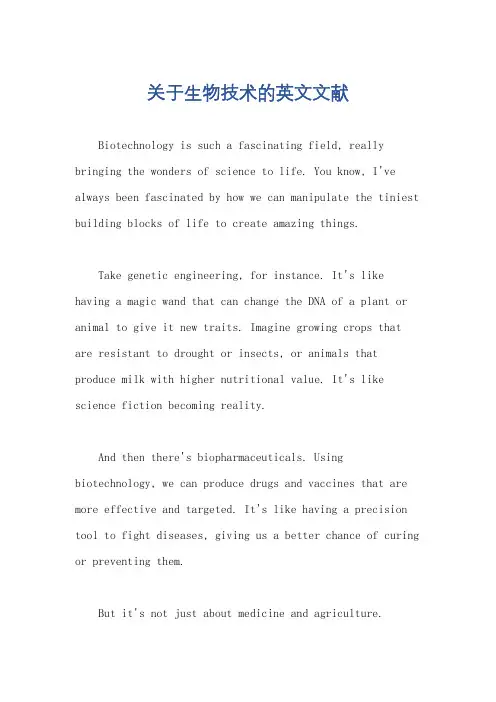
关于生物技术的英文文献Biotechnology is such a fascinating field, really bringing the wonders of science to life. You know, I've always been fascinated by how we can manipulate the tiniest building blocks of life to create amazing things.Take genetic engineering, for instance. It's like having a magic wand that can change the DNA of a plant or animal to give it new traits. Imagine growing crops that are resistant to drought or insects, or animals that produce milk with higher nutritional value. It's like science fiction becoming reality.And then there's biopharmaceuticals. Using biotechnology, we can produce drugs and vaccines that are more effective and targeted. It's like having a precision tool to fight diseases, giving us a better chance of curing or preventing them.But it's not just about medicine and agriculture.Biotechnology is also revolutionizing industries like energy and environmental protection. We can now use microbes to produce biofuels, reducing our dependence on fossil fuels and their impact on the environment.Plus, the advances in biotechnology are happening so fast. It's exciting to think about what the future holds. Maybe one day, we'll be able to regenerate organs for transplant using stem cells, or even create synthetic biology systems that can perform complex tasks.The possibilities are endless, and it's truly remarkable to be a part of this era where biotechnology is changing the world for the better. It's not just about scientific discovery; it's about improving lives and making a difference.。
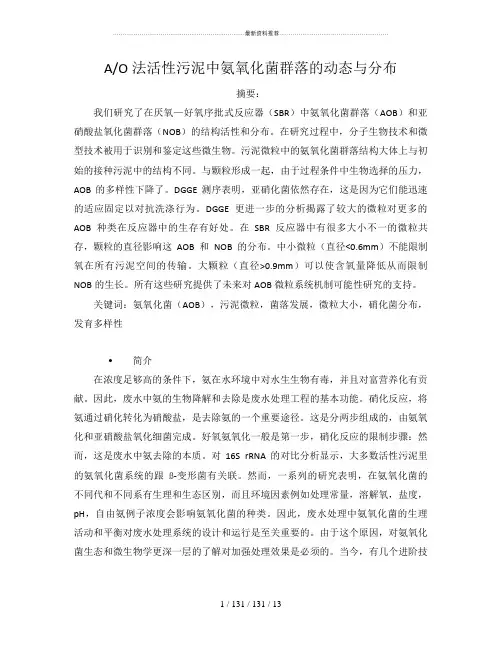
A/O法活性污泥中氨氧化菌群落的动态与分布摘要:我们研究了在厌氧—好氧序批式反应器(SBR)中氨氧化菌群落(AOB)和亚硝酸盐氧化菌群落(NOB)的结构活性和分布。
在研究过程中,分子生物技术和微型技术被用于识别和鉴定这些微生物。
污泥微粒中的氨氧化菌群落结构大体上与初始的接种污泥中的结构不同。
与颗粒形成一起,由于过程条件中生物选择的压力,AOB的多样性下降了。
DGGE测序表明,亚硝化菌依然存在,这是因为它们能迅速的适应固定以对抗洗涤行为。
DGGE更进一步的分析揭露了较大的微粒对更多的AOB种类在反应器中的生存有好处。
在SBR反应器中有很多大小不一的微粒共存,颗粒的直径影响这AOB和NOB的分布。
中小微粒(直径<0.6mm)不能限制氧在所有污泥空间的传输。
大颗粒(直径>0.9mm)可以使含氧量降低从而限制NOB的生长。
所有这些研究提供了未来对AOB微粒系统机制可能性研究的支持。
关键词:氨氧化菌(AOB),污泥微粒,菌落发展,微粒大小,硝化菌分布,发育多样性•简介在浓度足够高的条件下,氨在水环境中对水生生物有毒,并且对富营养化有贡献。
因此,废水中氨的生物降解和去除是废水处理工程的基本功能。
硝化反应,将氨通过硝化转化为硝酸盐,是去除氨的一个重要途径。
这是分两步组成的,由氨氧化和亚硝酸盐氧化细菌完成。
好氧氨氧化一般是第一步,硝化反应的限制步骤:然而,这是废水中氨去除的本质。
对16S rRNA的对比分析显示,大多数活性污泥里的氨氧化菌系统的跟ß-变形菌有关联。
然而,一系列的研究表明,在氨氧化菌的不同代和不同系有生理和生态区别,而且环境因素例如处理常量,溶解氧,盐度,pH,自由氨例子浓度会影响氨氧化菌的种类。
因此,废水处理中氨氧化菌的生理活动和平衡对废水处理系统的设计和运行是至关重要的。
由于这个原因,对氨氧化菌生态和微生物学更深一层的了解对加强处理效果是必须的。
当今,有几个进阶技术在废水生物处理系统中被用作鉴别、刻画微生物种类的有价值的工具。
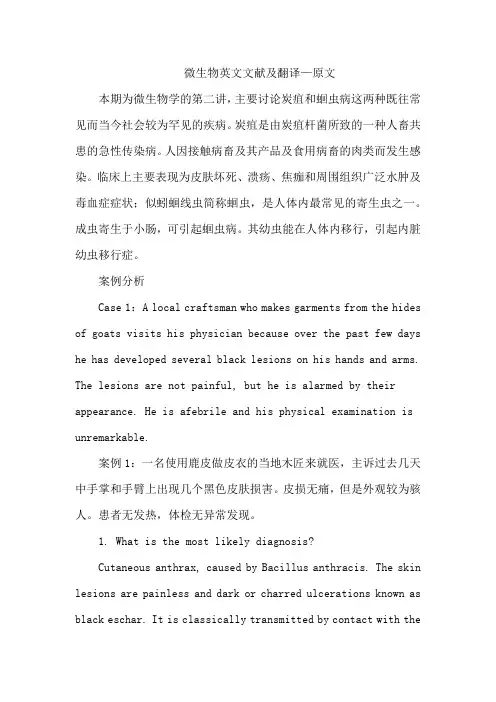
微生物英文文献及翻译—原文本期为微生物学的第二讲,主要讨论炭疽和蛔虫病这两种既往常见而当今社会较为罕见的疾病。
炭疽是由炭疽杆菌所致的一种人畜共患的急性传染病。
人因接触病畜及其产品及食用病畜的肉类而发生感染。
临床上主要表现为皮肤坏死、溃疡、焦痂和周围组织广泛水肿及毒血症症状;似蚓蛔线虫简称蛔虫,是人体内最常见的寄生虫之一。
成虫寄生于小肠,可引起蛔虫病。
其幼虫能在人体内移行,引起内脏幼虫移行症。
案例分析Case 1:A local craftsman who makes garments from the hides of goats visits his physician because over the past few days he has developed several black lesions on his hands and arms. The lesions are not painful, but he is alarmed by their appearance. He is afebrile and his physical examination is unremarkable.案例1:一名使用鹿皮做皮衣的当地木匠来就医,主诉过去几天中手掌和手臂上出现几个黑色皮肤损害。
皮损无痛,但是外观较为骇人。
患者无发热,体检无异常发现。
1. What is the most likely diagnosis?Cutaneous anthrax, caused by Bacillus anthracis. The skin lesions are painless and dark or charred ulcerations known as black eschar. It is classically transmitted by contact with thehide of a goat at the site of a minor open wound.皮肤炭疽:由炭疽杆菌引起,皮损通常无痛、黑色或称为焦痂样溃疡。
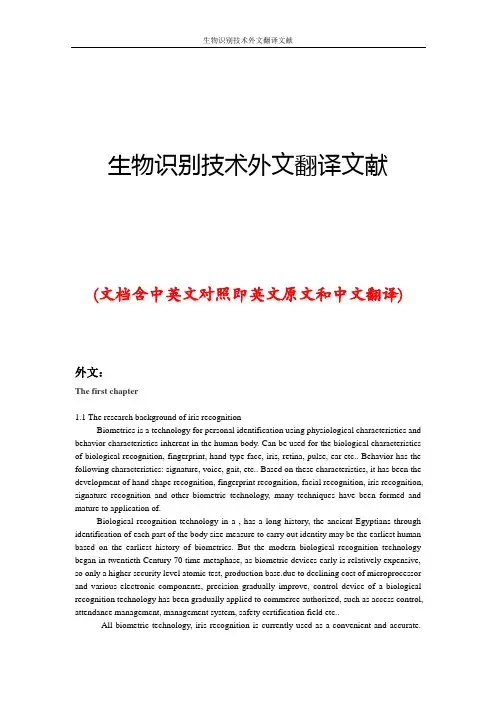
生物识别技术外文翻译文献生物识别技术外文翻译文献(文档含中英文对照即英文原文和中文翻译)外文:The first chapter1.1 The research background of iris recognitionBiometrics is a technology for personal identification using physiological characteristics and behavior characteristics inherent in the human body. Can be used for the biological characteristics of biological recognition, fingerprint, hand type face, iris, retina, pulse, ear etc.. Behavior has the following characteristics: signature, voice, gait, etc.. Based on these characteristics, it has been the development of hand shape recognition, fingerprint recognition, facial recognition, iris recognition, signature recognition and other biometric technology, many techniques have been formed and mature to application of.Biological recognition technology in a , has a long history, the ancient Egyptians through identification of each part of the body size measure to carry out identity may be the earliest human based on the earliest history of biometrics. But the modern biological recognition technology began in twentieth Century 70 time metaphase, as biometric devices early is relatively expensive, so only a higher security level atomic test, production base.due to declining cost of microprocessor and various electronic components, precision gradually improve, control device of a biological recognition technology has been gradually applied to commerce authorized, such as access control, attendance management, management system, safety certification field etc..All biometric technology, iris recognition is currently used as a convenient and accurate.Making twenty-first Century is information technology, network technology of the century, is also the human get rid of traditional technology, more and more freedom of the century. In the information, free for the characteristics of the century, biometric authentication technology, high-tech as the end of the twentieth Century began to flourish, will play a more and more important role in social life, fundamentally change the human way of life . Characteristics of the iris, fingerprint, DNA the body itself, will gradually existing password, key, become people lifestyle, instead of at the same time, personal data to ensure maximum safety, maximize the prevention of various types of crime, economic crime.Iris recognition technology, because of its unique in terms of acquisition, accuracy and other advantages, will become the mainstream of biometric authentication technology in the future society. Application of safety control, the customs import and export inspection, e-commerce and other fields in the future, is also inevitable in iris recognition technology as the focus. This trend, now in various applications around the world began to appear in the.1.2 Objective and significance of iris recognitionIris recognition technology rising in recent years, because of its strong advantages and potential commercial value, driven by some international companies and institutions have invested a lot of manpower, financial resources and energy research. The concept of automatic iris identification is first proposed by Frown, then Daugman for the first time in the algorithm becomes feasible.The iris is a colored ring in the pupil in the eye of fabric shape, each iris contains a structure like the one and only based on the crown, crystalline, filaments, spots, structure, concave point, ray, wrinkles and fringe characteristic. The iris is different from the retina, retinal is located in the fundus, difficult to image, iris can be seen directly, biometric identification technology can obtain the image of iris fine with camera equipment based on the following basis: Iris fibrous tissue details is rich and complicated, and the formation and embryonic tissue of iris details the occurrence stage of the environment, have great random the. The inherent characteristics of iris tissue is differ from man to man, even identical twins, there is no real possibility of characteristics of the same.When the iris are fully developed, he changes in people's life and tiny. In the iris outer, with a layer of transparent corneal it is separated from the outside world. So mature iris less susceptible to external damage and change.These characteristics of the iris has the advantages, the iris image acquisition, the human eye is not in direct contact with CCD, CMOS and other light sensor, uses a non technology acquisition invasion. So, as an important biometric identity verification system, iris recognition by virtue of the iris texture information, stability, uniqueness and non aggressive, more and more attention from both academic and industrial circles.1.3 Status and application of domestic and foreign research on iris recognitionIDC (International Data Group) statistics show that: by the end of 2003, the global iris recognition technology and related products market capacity will reach the level of $2000000000. Predicted conserved survey China biometric authentication center: in the next 5 years, only in the Chinese, iris recognition in the market amounted to 4000000000 rmb. With the expansion of application of the iris recognition technology, and the application in the electronic commerce domain, this number will expand to hundreds of billions.The development of iris recognition can be traced back to nineteenth Century 80's.. In 1885, ALPHONSE BERTILLON will use the criminal prison thoughts of the application of biometrics individual in Paris, including biological characteristics for use at the time: the size of the ears, feet in length, iris.In 1987, ARAN SAFIR and LEONARD FLOM Department of Ophthalmology experts first proposed the concept, the use of automatic iris recognition iris image in 1991, USA Los ala Moss National Laboratory JOHNSON realized an automatic iris recognition system.In 1993, JOHN DAUGMAN to achieve a high performance automatic iris recognition system.In 1997, the first patent Chinese iris recognition is approved, the applicant, Wang Jiesheng.In 2005, the Chinese Academy of Sciences Institute of automation, National Laboratory of pattern recognition, because of outstanding achievement "in recognition of" iris image acquisition and aspects, won the two "National Technology Invention Prize", the highest level represents the development of iris recognition technology in china.In 2007 November, "requirements for information security technology in iris recognition system" (GB/T20979-2007) national standards promulgated and implemented, the drafting unit: Beijing arithen Information Technology Co., ltd..Application of safety control, the customs import and export inspection, e-commerce and other fields in the future, is also inevitable in iris recognition technology as the focus. This trend, now in various applications around the world began to appear in the. In foreign countries, iris recognition products have been applied in a wide range.In February 8, 2002, the British Heathrow Airport began to test an advanced security system, the new system can scan the passenger's eyes, instead of to check passports. It is reported, the pilot scheme for a period of five months, a British Airways and virgin Airlines passengers can participate in this test. The International Air Transport Association interested in the results of this study are, they encourage the Heathrow Airport to test, through the iris boarding passengers to determine its identity as a boarding pass.Iris recognition system America "Iriscan" developed has been applied in the three business department of Union Bank of American Texas within. Depositors to be left with nothing whatsoever to banking, no bank card password, no more memories trouble. They get money from the A TM, a camera first eye of the user to scan, and then scan the image into digital information and data check, check the user's identity.America Plumsted school in New Jersey has been in the campus installed device of iris recognition for security control of any school, students and staff are no longer use cards and certificates of any kind, as long as they passed in the iris camera before, their location, identity is system identification, all foreign workers must be iris data logging to enter the campus. At thesame time, through the central login and access control system to carry on the control to enter the scope of activities. After the installation of the system, various campus in violation of rules and infringement, criminal activity is greatly reduced, greatly reducing the campus management difficulty.In Afghanistan, the United Nations (UN) and the United Nations USA federal agency refugee agency (UNHCR) using iris recognition system identification of refugees, to prevent the same refugee multiple receive relief goods. Use the same system in refugee camps in Pakistan and Afghanistan. A total of more than 2000000 refugees use iris recognition system, this system to a key role for the United Nations for distribution of humanitarian aid from.In March 18, 2003, Abu Zabi (one of the Arabia and the United Arab Emirates) announced the iris recognition technology for expelled foreigners iris tracking and control system based on the borders opened the world's first set of national level, this system began construction from 2001, its purpose is to prevent all expelled by Abu Zabi tourists and other personnel to enter the Abu Zabi. Without this system in the past, due to the unique characteristics of the surface of the Arabs (Hu Xuduo), and the number of the expulsion of the numerous, customs inspection staff is very difficult to distinguish between what is a deported person. By using this system, illegal immigration, all be avoided, the maximum guarantee of national security.Kennedy International Airport in New Jersey state (John F. Kennedy International Airport) of the iris recognition system installed on its international flights fourth boarding port, 300 of all 1300 employees have already started to use the system login control. By using this system, all can enter to the apron personnel must be after the system safety certification of personnel. Unauthorized want to break through, the system will automatically take emergency measures to try to force through personnel closed in the guard space. Using this system, the safety grade Kennedy International Airport rose from B+ to A+ grade. The Kennedy International Airport to travel to other parts of the passengers has increased by 18.7%.Generally speaking, the iris recognition technology has already begun in all walks of life in various forms of application in the world. At the same time, to the application of their units of all had seen and what sorts of social benefits and economic benefits are not see. This trend is to enhance the high speed, the next 10 years will be gradually achieve the comprehensive application of iris recognition in each industry.In China, due to the Chinese embargo and iris technology itself and the difficulty in domestic cannot develop products. So far, there has not been a real application of iris recognition system. However, many domestic units are expressed using strong intention, especially the "9 · 11" later, security anti terrorism consciousness has become the most concerned problems in the field of aviation, finance. Iris recognition system is a major airline companies, major financial institutions and other security mechanisms (such as aerospace bureau) become the focus of attention of object and other key national security agency. As with the trend of development in the world, iris recognition technology will in the near future in application China set off climax.The second chapter of introduction of iris recognition technology2.1 Technology of biological feature recognition based on2.1.1 Present status and development of biological feature recognition“9.11" event is an important turning point in the development of biometric ident ification technology in the world, the importance of it makes governments more clearly aware of the biological recognition technology. Traditional identity recognition technologies in the face ofdefect anti terrorism has shown, the government began a large-scale investment in the research and application of biometric technology. At the same time, the public understanding of biological recognition technology with "9.11" exposure rate and greatly improve the.The traditional method of individual identification is the identity of the people with knowledge, identity objects recognition. The so-called identity: knowledge refers to the knowledge and memory system of personal identification, cannot be stolen, and the system is easy to install, but once the identification knowledge stolen or forgotten, the identity of easily being fake or replaced, this method at present in a wide range of applications. For example: the user name and password. The so-called identity items: refers to the person, master items. Although it is stable and reliable, but mainly depend on the outer body, lost or stolen identification items once proof of identity, the identity of easily being fake or replaced, for example: keys, certificates, magnetic card, IC card etc..Biometric identification technology is related to physical characteristics, someone using prior record of behavior, to confirm whether the facts. Biometric identification technology can be widely used in all fields of society. For example: a customer came into the bank, he did not take bank card, also did not remember the password directly drawing, when he was drawing in the drawing machine, a camera to scan on his eyes, and then quickly and accurately complete the user identification and deal with business. This is the application of the iris recognition system of modern biological identification technology. "".America "9.11" after the incident, the anti terrorist activity has become the consensus of governments, it is very important to strengthen the security and defense security at the airport, some airports USA can in the crowd out a face, whether he Is it right? Wanted. This is the application of modern technology in biological feature recognition "facial recognition technology".Compared with the traditional means of identity recognition, biometric identity recognition technology in general has the following advantages:(1) the security performance is good, not easy to counterfeit or stolen.(2) carry, whenever and wherever possible, therefore more safety and security and other identification method.For the biological information of biometric recognition, its basic nature must meet the following three conditions: universality, uniqueness and permanency.The so-called universality, refers to any individual has the. Uniqueness, is in addition to other than himself, other people did not have any, namely different. The so-called permanent, refers to the character does not change over time, namely, life-long.Feature selection of organisms with more than three properties, is the first step of biological recognition.In addition, there are two important indexes in biological recognition technology. The rejection rate and recognition rate. Adjusting the relation of these two values is very important. The reject rate, the so-called false rejection, this value is high, use frequency is low, the error recognition, its value is high, safety is relatively reduced. So in the biological identification of any adjustment, the two index is a can not abandon the process. The choice of range size, related to the biological identification is feasible and available .And technology of identity recognition based on iris feature now appears, it is the development of biometric identification technology quickly, due to its uniqueness, stability,convenience and reliability, so the formation of biometric identification technology has the prospects for development.Generally speaking, the biological recognition system consists of 4 steps. The first step, the image acquisition system of collecting biometric image; the second step, the biological characteristics of image preprocessing (location, normalization, image enhancement and so on); the third step, feature information extraction, converted into digital code; the fourth step, the generation of test code and database template code to compare, make identification。
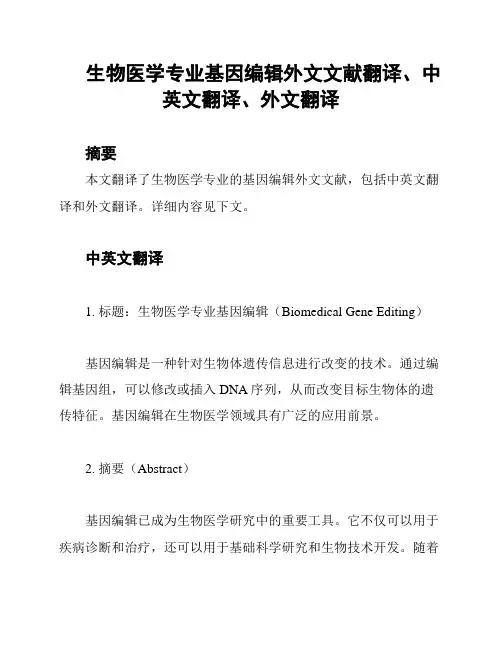
生物医学专业基因编辑外文文献翻译、中英文翻译、外文翻译摘要本文翻译了生物医学专业的基因编辑外文文献,包括中英文翻译和外文翻译。
详细内容见下文。
中英文翻译1. 标题:生物医学专业基因编辑(Biomedical Gene Editing)基因编辑是一种针对生物体遗传信息进行改变的技术。
通过编辑基因组,可以修改或插入DNA序列,从而改变目标生物体的遗传特征。
基因编辑在生物医学领域具有广泛的应用前景。
2. 摘要(Abstract)基因编辑已成为生物医学研究中的重要工具。
它不仅可以用于疾病诊断和治疗,还可以用于基础科学研究和生物技术开发。
随着技术的不断发展,基因编辑对人类健康和生物多样性的影响也引起了人们的关注。
3. 引言(Introduction)基因编辑是一种通过改变生物体的遗传信息来实现特定目的的技术。
它可以在DNA水平上对基因组进行精确的修改和操控,从而实现对目标生物体特征的变化。
外文翻译1. Title: Biomedical Gene EditingGene editing is a technology that allows for changes to be made to the genetic information of an organism. By editing the genome, DNA sequences can be modified or inserted, altering the genetic characteristics of the target organism. Gene editing has wide applications in the field of biomedical research.2. Abstract3. IntroductionGene editing is a technology that achieves specific objectives by altering the genetic information of an organism. It allows for precise modifications and manipulation of the genome at the DNA level, resulting in changes to the characteristics of the target organism.。


微生物文献翻译张宇生物科学2011031021Ethanol, isopropanol, and 1-butanol are the only naturally produced alcohol biofuels. Isopropanol can be used directly as a fuel supplement to gasoline or as a feedstock for the transesterification of fats into biodiesel [35]. Both isopropanol and 1-butanol are produced in a mixed product fermentation in various strains of Clostridium [36], with maximum production levels reaching 2 g/L and 20 g/L, respectively [37, 38]. With a renewed interest in alternative fuels, the production of isopropanol and 1-butanol has been recently investigated in genetically tractable heterologous organisms. These organisms, such as Escherichia coli and Saccharomyces cerevisiae, facilitate the design and optimization of new biofuels processes by combining an increasing synthetic biology toolbox with a well-studied metabolism. Isopropanol production in E. coli has surpassed that of Clostridium by assembling the pathway for acetone production and a secondary alcohol dehydrogenase [8, 12]. The production of 1-butanol, however, has proven to be more difficult. Initial efforts were able to produce ~0.5 g/L using E. coli as a host [7]. Construction of a new strain harboring a single construct resulted in an increase in production to 1.2 g/L [9]. In addition to E. coli, 1-butanol production has been investigated in Pseudomonas putida, Bacillus subtilis, and S. cerevisiae [10, 11], although production in E. coli has thus far shown the most promise. Each ofthese processes, however, is far from industrial feasibility, as yields (~0.05 g/g) and productivities (~0.01 g/L/h) must increase significantly to match the same figures for corn ethanol (~0.5 g/g and 2 g/L/h). The advancement of these processes is thought to be limited by the low activity of pathway enzymes due to poor expression, solubility, or oxygen sensitivity, as well as the metabolic imbalance introduced by these heterologous pathways. While productivity in each of these platforms is low in comparison with Clostridial fermentation, the ability to engineer and manipulate these user-friendly hosts will facilitate the development of these processes.翻译:唯一的自然生产的酒精燃料乙醇、异丙醇、和1-丁醇。

生物课程中英文对照(总2页)--本页仅作为文档封面,使用时请直接删除即可----内页可以根据需求调整合适字体及大小--生物课程中英文对照现代激光医学 Modern Laser Medicine生物医学光子学 Biomedicine Photonics生物医学信号处理技术 Signal Processing for Biology and Medicine自然智能与人工智能 Natural Intelligence and Artificial Intelligence人工神经网络及应用 Artificial Intelligence and Its Applications环境生物学 Environmental Biology水环境生态学模型 Models of Water Quality环境生物技术 Environmental Biotechnology水域生态学 Aquatic Ecology环境工程 Environmental Engineering环境科学研究方法 Study Methodology of Environmental Science藻类生理生态学 Ecological Physiology in Algae 水生动物生理生态学 Physiological Ecology of Aquatic Animal废水处理与回用 Sewage Disposal and Re-use 生物医学材料学及实验 Biomaterials and Experiments现代测试分析 Modern Testing Technology and Methods生物材料结构与性能 Structures and Properties of Biomaterials医学信息学 Medical Informatics组织工程学 Tissue Engineering生物医学工程概论 Introduction to Biomedical Engineering高等生物化学 Advanced Biochemistry药物化学 Pharmaceutical Chemistry功能高分子 Functional Polymer高分子化学与物理 Polymeric Chemistry and Physics医学电子学 Medical Electronics现代仪器分析 Modern Instrumental Analysis 仪器分析实验 Instrumental Analysis Experiment食品添加剂 Food Additives Technology高级食品化学 Advanced Food Chemistry食品酶学 Food Enzymology波谱学 Spectroscopy食品贮运与包装 Food Packaging液晶化学 Liquid Crystal Chemistry高等有机化学 Advanced Organic Chemistry功能性食品 Function Foods食品营养与卫生学 Food Nutrition and Hygiene 食品生物技术 Food Biotechnology 食品研究与开发 Food Research and Development有机合成化学 Synthetic Organic Chemistry 食品分离技术 Food Separation Technique精细化工装备 Refinery Chemical Equipment 食品包装原理 Principle of Food Packaging表面活性剂化学及应用 Chemistry and Application of Surfactant天然产物研究与开发 Research and Development of Natural Products食品工艺学 Food Technology食品分析 Food Analysis食品机械与设备 Food Machinery and Equipment高等无机化学 Advanced Inorganic Chemistry 量子化学(含群论) QuantumChemistry(including Group Theory)高等分析化学 Advanced Analytical Chemistry 高等有机化学 Advanced Organic Chemistry 激光化学 Laser Chemistry激光光谱 Laser Spectroscopy稀土化学 Rare Earth Chemistry材料化学 Material Chemistry生物无机化学导论 Bioinorganic Chemistry配位化学 Coordination Chemistry膜模拟化学 Membrane Mimetic Chemistry晶体工程基础 Crystal Engineering催化原理 Principles of Catalysis绿色化学 Green Chemistry现代有机合成 Modern Organic Synthesis无机化学 Inorganic Chemistry物理化学 Physics Chemistry有机化学 Organic Chemistry分析化学 Analytical Chemistry现代仪器分析 Modern Instrumental Analysis 现代波谱学 Modern Spectroscopy化学计量学 Chemomtrics现代食品分析 Modern Methods of Food Analysis天然产物化学 Natural Product Chemistry天然药物化学 Natural Pharmaceutical Chemistry现代环境分析与监测 Analysis and Monitoring of Environment Pollution现代科学前沿选论 Literature on Frontiers of Modern Science and Technology计算机在分析化学的应用 Computer Application in Analytical Chemistry现代仪器分析技术 Modern Instrument Analytical Technique分离科学 Separation Science高等环境微生物 Advanced Environmental Microorganism海洋资源利用与开发 Utilization & Development of Ocean Resources保健食品监督评价 Evaluation and Supervision on Health Food s生物电化学 Bioelectrochemistry现代技术与中药 Modern Technology and Traditional Chinese Medicine高等有机化学 Advanced Organic Chemistry 废水处理工程 Technology of Wastewater Treatment生物与化学传感技术 Biosensors & Chemical Sensors现代分析化学研究方法 Research Methods of Modern Analytical Chemistry神经生物学 Neurobiology动物遗传工程 Animal Genetic Engineering动物免疫学 Animal Immunology动物病害学基础 Basis of Animal Disease受体生物化学 Receptor Biochemistry动物生理与分子生物学 Animal Physiology and Molecular Biochemistry分析生物化学 Analytical Biochemistry学科前沿讲座 Lectures on Frontiers of the Discipline微生物学 Microbiology细胞生物学 Cell Biology生理学 Physiology电生理技术基础 Basics of Electricphysiological Technology生物化学 Biochemistry高级水生生物学 Advanced Aquatic Biology藻类生理生态学 Ecological Physiology in Algae 水生动物生理生态学 Physiological Ecology of Aquatic Animal水域生态学 Aquatic Ecology水生态毒理学 Aquatic Ecotoxicology水生生物学研究进展 Advance on Aquatic Biology水环境生态学模型 Models of Water Quality 藻类生态学 Ecology in Algae生物数学 Biological Mathematics植物生理生化 Plant Biochemistry水质分析方法 Water Quality Analysis水产养殖学 Aquaculture环境生物学 Environmental Biology专业文献综述 Review on Special Information 植物学 Botany动物学 Zoology普通生态学 General Ecology 生物统计学 Biological Statistics分子遗传学 Molecular Genetics基因工程原理 Principles of Gene Engineering 高级生物化学 Advanced Biochemistry基因工程技术 Technique for Gene Engineering 基因诊断 Gene Diagnosis基因组学 Genomics医学遗传学 Medical Genetics免疫遗传学 Immunogenetics基因工程药物学 Pharmacology of Gene Engineering高级生化技术 Advanced Biochemical Technique基因治疗 Gene Therapy肿瘤免疫学 Tumour Immunology免疫学 Immunology免疫化学技术 Methods for Immunological Chemistry毒理遗传学 Toxicological Genetics分子病毒学 Molecular Virology分子生物学技术 Protocols in Molecular Biology神经免疫调节 Neuroimmunology普通生物学 Biology生物化学技术 Biochemic Technique分子生物学 Molecular Biology生殖生理与生殖内分泌 Reproductive Physiology & Reproductive Endocrinology生殖免疫学 Reproductive Immunology发育生物学原理与实验技术 Principle and Experimental Technology of Development蛋白质生物化学技术 Biochemical Technology of Protein受精的分子生物学 Molecular Biology of Fertilization免疫化学技术 Immunochemical Technology低温生物学原理与应用 Principle & Application of Cryobiology不育症的病因学 Etiology of Infertility分子生物学 Molecular Biology 分析生物化学Analytical Biochemistry 医学生物化学 Medical Biochemistry 医学分子生物学 Medical Molecular Biology 医学生物化学技术Techniques of Medical Biochemistry 生化与分子生物学进展 Progresses in Biochemistry and Molecular Biology 高级植物生理生化Advanced Plant Physiology and Biochemistry 开花的艺术 Art of Flowering 蛋白质结构基础Principle of Protein Structure 分子进化工程Engineering of Molecular Evolution 生物工程下游技术 Downstream Technique ofBiotechnology 仪器分析 Instrumental Analysis 临床检验与诊断 Clinical Check-up & Diagnosis 药理学 Pharmacology。

生物相关专业外文文献(有翻译好的版本)Ecological Engineering 12 1999 27–38 Combining constructed wetlands and aquatic andsoil lters for reclamation and reuse of waterCH House BA Bergmann AM Stomp DJ FrederickDepartment of Forestry North Carolina State Uniersity Box 8008 Raleigh NC 27695 8008 USAAccepted 22 May 1998 AbstractReclamation and reuse of water and nutrients at their source provide the opportunity touse simple less costly technologies and lessens potentials for catastrophic effects due tocentralized treatment system failures The combination of multiple treatment environmentswithin constructed wetlands can provide water quality suitable for reuse A current projectin rural Chatham County NC uses simple aesthetically pleasing treatment componentsconstructed both outdoors and indoors to reclaimdomestic sewage for toilet ushinglandscape irrigation and aesthetic water features A courtyard containing constructedwetlands and a solarium with modular soil lter components and aquatic chambers aredesigned to treat sewage from within a small business facility and to provide recreationalspace for its 60 employees The combination of vertical ow and horizontal ow constructedwetlands with ll and draw controls provides the necessary environments for nitrication–denitrication removal of organic materials and phosphorus adsorption reactions Thesystem is designed to treat and reuse 4500 l day 1 1200 gal day 1 of domestic sewage fromthe business Some of the plants used are selectively bred or genetically engineered toimize their water reclamation potential Utilization of simple treatment and reusetechnology has permitted the business owner to renovate an abandoned and deterioratingschool building into a home for two thriving andinternationally based businesses and toprotect the water quality of a nearby reservoir 1999 Published by Elsevier Science BV Allrights reservedKeywords Reuse Constructed wetlands Vertical ow Soil lter Fill and draw ReclamationCorresponding author0925-857499 - see front matter 1999 Published by Elsevier Science BV All rights reservedPII S0925-85749800052-428 CH House et al Ecological Engineering 12 1999 27–381 IntroductionAn effective nutrient management system for domestic sewage should reduceand reuse wastewater The general objective of this research project is to evaluatethe feasibility of treating and recycling 4500 l day 1 1200 gal day1 of domesticwastewater for ushing toilets Specic objectives include 1 the evaluation ofstep feed recirculation spatial aerobic and anaerobicenvironments uctuatingaerobic and anaerobic environments and zeolite absorbents for nitrogen treat-ment 2 the evaluation of brick chips as a phosphorus absorbent and nitrogenxing woody plants for phosphorus uptake and storage 3 develop a costeffectiveness analysis of on-site nitrogen and phosphorus treatment methods andon-site wastewater treatment and reuse within eastern Chatham CountyThe addition of human waste into high quality water and its disposal intoground and surface waters is not sustainable This practice makes inefcient useof water supply and simultaneously adversely impacts it Both on-site and central-ized treatment technologies can benet from the treatment and reuse of sewagenear its source On-site wastewater treatment design has evolved into a sophisti-cated technology with numerous advances but its adverse impacts onground andsurface waters as non-point sources of nitrogen phosphorus and pathogenicbacteria and virus continue Centralized treatment plants plagued by increasingdemands for expansion high cost and inconsistent funding mechanical or opera-tional failures periodically discharge partially treated wastewater into our surfacewatersMost water reuse research in the US currently focuses on irrigation of re-claimed wastewater from industrial and municipal sized systems North Carolinais just beginning to explore the potentials of water reuse Reduction of nutrientload and water volume through advanced treatment and reuse from installationswith small ows such as homes and businesses has potential to。
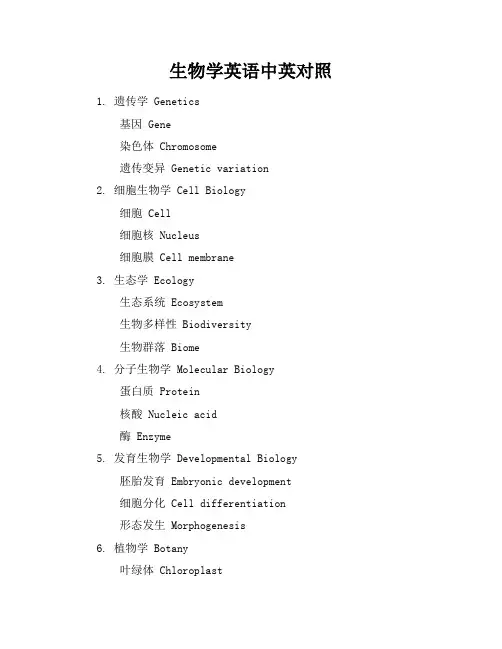
生物学英语中英对照1. 遗传学 Genetics基因 Gene染色体 Chromosome遗传变异 Genetic variation2. 细胞生物学 Cell Biology细胞 Cell细胞核 Nucleus细胞膜 Cell membrane3. 生态学 Ecology生态系统 Ecosystem生物多样性 Biodiversity生物群落 Biome4. 分子生物学 Molecular Biology蛋白质 Protein核酸 Nucleic acid酶 Enzyme5. 发育生物学 Developmental Biology胚胎发育 Embryonic development细胞分化 Cell differentiation形态发生 Morphogenesis6. 植物学 Botany叶绿体 Chloroplast光合作用 Photosynthesis根系 Root system7. 动物学 Zoology器官 Organ组织 Tissue神经系统 Nervous system8. 微生物学 Microbiology细菌 Bacteria病毒 Virus真菌 Fungus9. 生物化学 Biochemistry代谢 MetabolismATP(三磷酸腺苷) ATP (Adenosine Triphosphate)酶促反应 Enzymatic reaction10. 生理学 Physiology心脏 Heart肺 Lung肝脏 Liver生物学英语中英对照(续)11. 进化生物学 Evolutionary Biology自然选择 Natural selection物种形成 Speciation进化树 Evolutionary tree12. 行为生物学 Behavioral Biology繁殖行为 Reproductive behavior领域行为 Territorial behavior社会行为 Social behavior13. 神经生物学 Neurobiology神经元 Neuron突触 Synapse神经递质 Neurotransmitter14. 免疫学 Immunology抗体 Antibody免疫系统 Immune system炎症 Inflammation15. 营养学 Nutrition蛋白质 Protein碳水化合物 Carbohydrate脂肪 Fat16. 遗传工程 Genetic Engineering基因克隆 Gene cloning基因编辑 Gene editing转基因技术 Genetic modification 17. 生态遗传学 Ecological Genetics种群 Population环境适应性 Environmental adaptation遗传漂变 Genetic drift18. 生物信息学 Bioinformatics基因组学 Genomics蛋白质组学 Proteomics生物数据挖掘 Bioinformatics data mining19. 生物统计学 Biostatistics实验设计 Experimental design数据分析 Data analysis显著性检验 Significance test20. 环境生物学 Environmental Biology环境污染 Environmental pollution生态修复 Ecological restoration生物降解 Biodegradation这份生物学英语中英对照文档旨在帮助您更全面地了解生物学领域的专业术语。
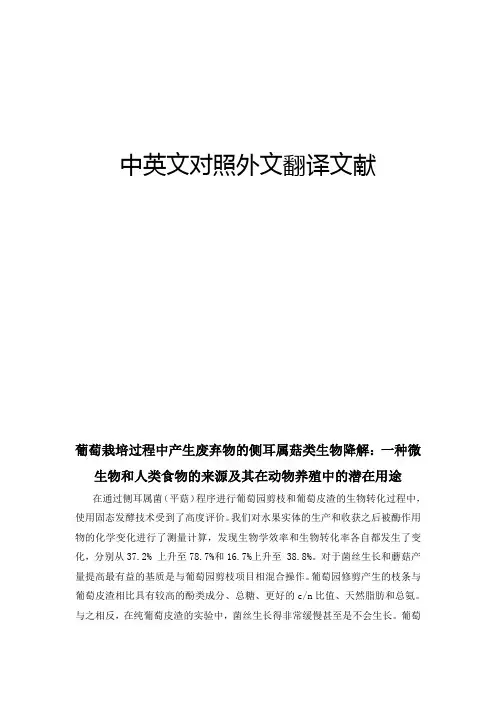
中英文对照外文翻译文献葡萄栽培过程中产生废弃物的侧耳属菇类生物降解:一种微生物和人类食物的来源及其在动物养殖中的潜在用途在通过侧耳属菌(平菇)程序进行葡萄园剪枝和葡萄皮渣的生物转化过程中,使用固态发酵技术受到了高度评价。
我们对水果实体的生产和收获之后被酶作用物的化学变化进行了测量计算,发现生物学效率和生物转化率各自都发生了变化,分别从37.2% 上升至78.7%和16.7%上升至 38.8%。
对于菌丝生长和蘑菇产量提高最有益的基质是与葡萄园剪枝项目相混合操作。
葡萄园修剪产生的枝条与葡萄皮渣相比具有较高的酚类成分、总糖、更好的c/n比值、天然脂肪和总氨。
与之相反,在纯葡萄皮渣的实验中,菌丝生长得非常缓慢甚至是不会生长。
葡萄皮渣比例较高的混合物中水分、蛋白质、脂肪和木质素含量一般较高,然而修剪产生的葡萄枝中,中性洗涤剂纤维、半纤维素、纤维素含量较高。
侧耳菌株的生长可能依赖于基质中纤维成分的可获取情况,而且其消化过程中发生的动态变化可能随着这些纤维在真菌生长过程中的改变而发生。
通过以侧耳属菌为媒介的SSF技术对葡萄栽培残基进行回收利用的潜力巨大,可以生产出人类所需的食物以及在反刍动物饲养中还有限使用的高纤维饲料。
关键词:生物转化酶作用;侧耳属菌;回收利用;固态发酵;葡萄栽培过程的副产品引言:葡萄种植是墨西哥西北部一项重要的生产活动,在墨西哥西北部有33500公顷的土地栽培了数类不同品种的葡萄。
这么大规模的生产活动每年大约产生了大约27万吨的工农业废料,而这其中有大约93%是葡萄园修剪掉的枝条。
这些废料一般直接在田间进行焚烧处理,以防止种植物病原菌的扩散,从而引起环境和生态问题以及危害人类健康的风险。
木质素是工农业废料中所有碳含量的主要组成部分,当它在遇热降解过程中会产生多环芳香烃成分,如苯并芘、邻苯二酚、对苯二酚菲和萘。
所有这些化合物可以抑制DNA 合成,并可能诱发动物和人类的肝脏、肺、喉和子宫颈产生癌变肿瘤。
中英文资料外文翻译文献译文标题:传统意大利榛子的体外繁殖用于当地遗传资源库的稳定和保存译文:关键词:欧洲榛,榛属,传统种质,体外繁殖摘要:在地中海盆地,榛子(欧洲榛)是非常重要的一种作物。
体外繁殖能够有效的稳定当地遗传资源库。
为了提高榛子微组织繁殖实验记录的精确性,各种不同的研究已经在进行。
这些研究通常以重要的品种为材料,然而,微组织繁殖实验记录应用在这些幼小品种上比起传统方法通常会产生相反的结果,这种技术在幼小品种上很少取得成功。
本实验的目的是为重要品种微组织繁殖的操作积累相关的知识和信息。
实验过程中需要设计不同成分的培养基,灭菌时间和培养时间都要进行详细的讨论。
传统意大利品种植株茎芽中的N6-异戊烯腺嘌呤的作用是改善这种状态。
生根阶段是榛属微组织繁殖应用于大型商业生产的关键步骤。
欧洲榛在欧洲特别是生物地理分布区地中海盆地代表一种重要的经济类林木。
榛子主要产于土耳其,意大利,美国和西班牙(分别是每年55,000, 110,000, 25,000, 18,000+吨),其次是法国,希腊,葡萄牙。
大约90%的产品被去皮并且以树芯的形式卖出,然而剩余的10%则作为树苗消费。
极好的营养成分和营养制品的特性也使该物种产生很高的利润。
此外,在一些特有的栽培地区,传统和文化身份严重受榛子产量的影响,文化身份常常会促进贫瘠土地的回收和利用。
即使这样,在一些地区,这种林业作物仍然不是重要的农业资源,然而,就当地足够维持的生产式系统和作为宝贵的食物的传统而言,它却是一种有趣的收入来源。
世界第二大生产商意大利说一些传统的品种主要种植在Campania ,Latium, Piedmont,在西西里岛有大量的属典型种。
近几年,一些主要品种由于质量和传统特性获得了欧洲质量印模。
此外,这些品种还被引进其他国家特定的果园中以增大他们的生长范围。
没有经过检验的物质可能会传播疾病,也可能会导致原因不明的物质的出现。
微组织繁殖法等生物技术的应用会促进健康的合乎本性的物质的产生(Nas et al.,2004),并且提高这种林木的经济价值。
Lesson OneInside the Living Cell: Structure andFunction of Internal Cell PartsCytoplasm: The Dynamic, Mobile Factory (细胞质:动力工厂)Most of the properties we associate with life are properties of the cytoplasm. Much of the mass of a cell consists of this semifluid substance, which is bounded on the outside by the plasma membrane. Organelles are suspended within it, supported by the filamentous network of the cytoskeleton. Dissolved in the cytoplasmic fluid are nutrients, ions, soluble proteins, and other materials needed for cell functioning.生命的大部分特征表现在细胞质的特征上。
细胞质大部分由半流体物质组成,并由细胞膜(原生质膜)包被。
细胞器悬浮在其中,并由丝状的细胞骨架支撑。
细胞质中溶解了大量的营养物质,离子,可溶蛋白以及维持细胞生理需求的其它物质。
The Nucleus: Information Central(细胞核:信息中心)The eukaryotic cell nucleus is the largest organelle and houses the genetic material (DNA) on chromosomes. (In prokaryotes the hereditary material is found in the nucleoid.) The nucleus also contains one or two organelles-the nucleoli-that play a role in cell division. A pore-perforated sac called the nuclear envelope separates the nucleus and its contents from the cytoplasm. Small molecules can pass through the nuclear envelope, but larger molecules such as mRNA and ribosomes must enter and exit via the pores.真核细胞的细胞核是最大的细胞器,细胞核对染色体组有保护作用(原核细胞的遗传物质存在于拟核中)。
英文生物学范文The wonders of biology are as vast as they are intricate, encompassing the study of life in all its forms. From the microscopic world of cells to the complex ecosystems of our planet, biology reveals the interconnectedness of all living things.In the realm of genetics, we discover the blueprint of life itself. DNA, the double helix structure, carries the genetic information that defines each species and individual. It's a testament to the precision and complexity ofbiological systems.Evolution, another cornerstone of biology, explains the diversity of life on Earth. Through the process of natural selection, species adapt and evolve over time, shaping the rich tapestry of life we see today.The study of ecology delves into the relationships between organisms and their environments. It's a dance of interdependence, where every creature plays a role in the balance of ecosystems, from the smallest insect to thelargest mammal.Biotechnology, a modern application of biological knowledge, has revolutionized medicine, agriculture, and environmental management. It's a field where science meets creativity, offering solutions to some of the world's mostpressing challenges.Conservation biology is a critical discipline that focuses on the preservation of species and habitats. It's a reminder of our responsibility to protect the natural world and ensure its survival for future generations.In the study of human biology, we explore the intricacies of our own bodies. From the cellular level to the systemsthat keep us alive and healthy, this knowledge is vital for understanding and improving human health.Lastly, the field of microbiology opens up a world thatis invisible to the naked eye. Microbes, both beneficial and harmful, play a crucial role in our health, the environment, and even the production of food and medicine.Biology is not just a science; it's a lens through which we can better understand the world around us and our place within it. It's a field that is constantly evolving, with new discoveries waiting to be made and mysteries to be solved.。
Carotenoid Biosynthetic Pathway in the Citrus Genus: Number of Copies and Phylogenetic Diversity of SevenGeneThe first objective of this paper was to analyze the potential role of allelic variability of carotenoid biosynthetic genes in the interspecifi diversity in carotenoid composition of Citrus juices. The second objective was to determine the number of copies for each of these genes. Seven carotenoid biosynthetic genes were analyzed using restriction fragment length polymorphism (RFLP) and simple sequence repeats (SSR) markers. RFLP analyses were performed with the genomic DNA obtained from 25 Citrus genotypes using several restriction enzymes. cDNA fragments of Psy, Pds, Zds, Lcyb, Lcy-e, Hy-b, and Zep genes labeled with [R-32P]dCTP were used as probes. For SSR analyses, two primer pairs amplifying two SSR sequences identified from expressed sequence tags (ESTs) of Lcy-b and Hy-b genes were designed. The number of copies of the seven genes ranged from one for Lcy-b to three for Zds. The genetic diversity revealed by RFLP and SSR profiles was in agreement with the genetic diversity obtained from neutral molecμLar markers. Genetic interpretation of RFLP and SSR profiles of four genes (Psy1, Pds1, Lcy-b, and Lcy-e1) enabled us to make inferences on the phylogenetic origin of alleles for the major commercial citrus species. Moreover, the resμLts of our analyses suggest that the allelic diversity observed at the locus of both of lycopene cyclase genes, Lcy-b and Lcy-e1, is associated with interspecific diversity in carotenoid accumμLation in Citrus. The interspecific differences in carotenoid contents previously reported to be associated with other key steps catalyzed by PSY, HY-b, and ZEP were not linked to specific alleles at the corresponding loci.KEYWORDS: Citrus; carotenoids; biosynthetic genes; allelic variability; phylogeny INTRODUCTIONCarotenoids are pigments common to all photosynthetic organisms. In pigment-protein complexes, they act as light sensors for photosynthesis but also prevent photo-oxidat ion induced by too strong light intensities. In horticμLtural crops, they play a major role in fruit, root, or tuber coloration and in nutritional quality. Indeed some of these micronutrients are precursors of vitamin A, an essential component of human and animal diets. Carotenoids may also play a role in chronic disease prevention (such as certain cancers), probably due to their antioxidant properties. The carotenoid biosynthetic pathway is now well established. Carotenoids are synthesized in plastids by nuclear-encoded enzymes. The immediate precursor of carotenoids (and also of gibberellins, plastoquinone, chlorophylls,phylloquinones, and tocopherols) is geranylgeranyl diphosphate (GGPP). In light-grown plants, GGPP is mainly derivedcarotenoid, 15-cis-phytoene. Phytoene undergoes four desaturation reactions catalyzed by two enzymes, phytoene desaturase (PDS) and β-carotene desaturase (ZDS), which convert phytoene into the red-colored poly-cis-lycopene. Recently, Isaacson et al. and Park et al. isolated from tomato and Arabidopsis thaliana, respectively, the genes that encode the carotenoid isomerase (CRTISO) which, in turn, catalyzes the isomerization of poly-cis-carotenoids into all-trans-carotenoids. CRTISO acts on prolycopene to form all-trans lycopene, which undergoes cyclization reactions. Cyclization of lycopene is a branching point: one branch leads to β-carotene (β, β-carotene) and the other toα-carotene (β, ε-carotene). Lycopene β-cyclase (LCY-b) then converts lycopene intoβ-carotene in two steps, whereas the formation of α-carotene requires the action of twoenzymes, lycopene ε- cyclase (LCY-e) and lycopene β-cyclase (LCY-b). α- carotene is converted into lutein by hydroxylations catalyzed by ε-carotene hydroxylase (HY-e) andβ-carotene hydroxylase (HY-b). Other xanthophylls are produced fromβ-carotene with hydroxylation reactions catalyzed by HY-b and epoxydation catalyzed by zeaxanthin epoxidase (ZEP). Most of the carotenoid biosynthetic genes have been cloned and sequenced in Citrus varieties . However, our knowledge of the complex regμLation of carotenoid biosynthesis in Citrus fruit is still limited. We need further information on the number of copies of these genes and on their allelic diversity in Citrus because these can influence carotenoid composition within the Citrus genus.Citrus fruit are among the richest sources of carotenoids. The fruit generally display a complex carotenoid structure, and 115 different carotenoids have been identified in Citrus fruit. The carotenoid richness of Citrus flesh depends on environmental conditions, particμLarly on growing conditions and on geogr aphical origin . However the main factor influencing variability of caro tenoid quality in juice has been shown to be genetic diversity. Kato et al. showed that mandarin and orange juices accumμLated high levels of β-cryptoxanthin and violaxanthin, respectively, whereas mature lemon accumμLated extremely low levels of carotenoids. Goodner et al. demonstrated that mandarins, oranges, and their hybrids coμLd be clearly distinguished by their β-cryptoxanthin contents. Juices of red grapefruit contained two major carotenoids: lycopene and β-carotene. More recently, we conducted a broad study on the organization of the variability of carotenoid contents in different cμLtivated Citrus species in relation with the biosynthetic pathway . Qualitative analysis of presence or absence of the different compounds revealed three main clusters: (1) mandarins, sweet oranges, and sour oranges; (2) citrons, lemons, and limes; (3) pummelos and grapefruit. Our study also enabled identification of key steps in the diversification of the carotenoid profile. Synthesis of phytoene appeared as a limiting step for acid Citrus, while formation of β-carotene and R-carotene from lycopene were dramatically limited in cluster 3 (pummelos and grapefruit). Only varieties in cluster 1 were able to produce violaxanthin. In the same study , we concluded that there was a very strong correlation between the classification of Citrus species based on the presence or absence of carotenoids (below,this classification is also referred to as the organization of carotenoid diversity) and genetic diversity evaluated with biochemical or molecμLar markers such as isozymes or randomLy amplified polymorphic DNA (RAPD). We also concluded that, at the interspecific level, the organization of the diversity of carotenoid composition was linked to the global evolution process of cμLtivated Citrus rather than to more recent mutation events or human selection processes. Indeed, at interspecific level, a correlation between phenotypic variability and genetic diversity is common and is generally associated with generalized gametic is common and is generally associated with generalized gametic disequilibrium resμLting from the history of cμLtivated Citrus. Thus from numerical taxonomy based on morphological traits or from analysis of molecμLar markers , all authors agreed on the existence of three basic taxa (C. reticμLata, mandarins; C. medica, citrons; and C. maxima, pummelos) whose differentiation was the resμLt of allopatric evolution. All other cμLtivated Citrus specie s (C. sinensis, sweet oranges; C. aurantium, sour oranges; C. paradisi, grapefruit; and C. limon, lemons) resμLted from hybridization events within this basic pool except for C. aurantifolia, which may be a hybrid between C. medica and C. micrantha .Our p revious resμLts and data on Citrus evolution lead us to propose the hypothesis that the allelic variability supporting the organization of carotenoid diversity at interspecific level preceded events that resμLted in the creation of secondary species. Such molecμLar variability may have two different effects: on the one hand, non-silent substitutions in coding region affect the specific activity of corresponding enzymes of the biosynthetic pathway, and on the other hand, variations in untranslated regions affect transcriptional or post-transcriptional mechanisms.There is no available data on the allelic diversity of Citrus genes of the carotenoid biosynthetic pathway. The objective of this paper was to test the hypothesis that allelic variability of these genes partially determines phenotypic variability at the interspecific level. For this purpose, we analyzed the RFLPs around seven genes of the biosynthetic pathway of carotenoids (Psy, Pds, Zds, Lcy-b, Lcy-e, Hy-b, Zep) and the polymorphism of two SSR sequences found in Lcy-b and Hy-b genes in a representative set of varieties of the Citrus genus already analyzed for carotenoid constitution. Our study aimed to answer the following questions: (a) are those genes mono- or mμLtilocus, (b) is the polymorphism revealed by RFLP and SSR markers in agreement with the general history of cμLtivated Citrus thus permitting inferences about the phylogenetic origin of genes of the secondary species, and (c) is this polymorphism associated with phenotypic (carotenoid compound) variations.RESΜLTS AND DISCUSSIONGlobal Diversity of the Genotype Sample Observed by RFLP Analysis. RFLP analyses were performed using probes defined from expressed sequences of seven major genes of the carotenoid biosynthetic pathway . One or two restriction enzymes were used for each gene. None of these enzymes cut the cDNA probe sequence except HindIII for the Lcy-e gene. Intronic sequences and restriction sites on genomic sequences werescreened with PCR amplification using genomic DNA as template and with digestion of PCR products. The resμLts indicated the absence of an intronic sequence for Psy and Lcy-b fragments. The absence of intron in these two fragments was checked by cloning and sequencing corresponding genomic sequences (data not shown). Conversely, we found introns in Pds, Zds, Hy-b, Zep, and Lcy-e genomic sequences corresponding to RFLP probes. EcoRV did not cut the genomic sequences of Pds, Zds, Hy-b, Zep, and Lcy-e. In the same way, no BamHI restriction site was found in the genomic sequences of Pds, Zds, and Hy-b. Data relative to the diversity observed for the different genes are presented in Table 4. A total of 58 fragments were identified, six of them being monomorphic (present in all individuals). In the limited sample of the three basic taxa, only eight bands out of 58 coμLd not be observed. In the basic taxa, the mean number of bands per genotype observed was 24.7, 24.7, and 17 for C. reticμLata, C. maxima, and C. medica, respectively. It varies from 28 (C. limettioides) to 36 (C. aurantium) for the secondary species. The mean number of RFLP bands per individual was lower for basic taxa than for the group of secondary species. This resμLt indicates that secondary species are much more heterozygous than the basic ones for these genes, which is logical if we assume that the secondary species arise from hybridizations between the three basic taxa. Moreover C. medica appears to be the least heterozygous taxon for RFLP around the genes of the carotenoid biosynthetic pathway, as already shown with isozymes, RAPD, and SSR markers.The two lemons were close to the acid Citrus cluster and the three sour oranges close to the mandarins/sweet oranges cluster. This organization of genetic diversity based on the RFLP profiles obtained with seven genes of the carotenoid pathway is very similar to that previously obtained with neutral molecμLar markers such as genomic SSR as well as the organization obtained with qualitative carotenoid compositions. All these resμLts suggest that the observed RFLP and SSR fragments are good phylogenetic markers. It seems consistent with our basic hypothesis that major differentiation in the genes involved in the carotenoid biosynthetic pathway preceded the creation of the secondary hybrid species and thus that the allelic structure of these hybrid species can be reconstructed from alleles observed in the three basic taxa.Gene by Gene Analysis: The Psy Gene. For the Psy probe combined with EcoRV or BamHI restriction enzymes, five bands were identified for the two enzymes, and two to three bands were observed for each genotype. One of these bands was present in all individuals. There was no restriction site in the probe sequence. These resμLts lead us to believe that Psy is present at two loci, one where no polymorphism was found with the restriction enzymes used, and one that displayed polymorphism. The number of different profiles observed was six and four with EcoRV and BamHI, respectively, for a total of 10 different profiles among the 25 individuals .Two Psy genes have also been found in tomato, tobacco, maize, and rice . Conversely, only one Psy gene has been found in Arabidopsis thaliana and in pepper (Capsicum annuum), which also accumμLates carotenoids in fruit. According to Bartley and Scolnik, Psy1 was expressed in tomato fruit chromoplasts, while Psy2 was specific to leaf tissue. In the same way, in Poaceae (maize, rice), Gallagher et al. found that Psy gene was duplicated and that Psy1 and notPsy2 transcripts in endosperm correlated with endosperm carotenoid accumμLation. These resμLts underline the role of gene duplication and the importance of tissue-specific phytoene synthase in the regμLation of carotenoid accumμLation.All the polymorphic bands were present in the sample of the basic taxon genomes. Assuming the hypothesis that all these bands describe the polymorphism at the same locus for the Psy gene, we can conclude that we found allelic differentiation between the three basic taxa with three alleles for C. reticμLata, four for C. maxima, and one for C. medica.The alleles observed for the basic taxa then enabled us to determine the genotypes of all the other species. The presumed genotypes for the Psy polymorphic locus are given in Table 7. Sweet oranges and grapefruit were heterozygous with one mandarin and one pummelo allele. Sour oranges were heterozygous; they shared the same mandarin allele with sweet oranges but had a different pummelo allele. Clementine was heterozygous with two mandarin alleles; one shared with sweet oranges and one with “Willow leaf” mandarin. “Meyer” lemon was heterozygous, with the mandarin allele also found in sweet oranges, and the citron allele. “Eureka”lemon was also heterozygous with the same pummelo allele as sour oranges and the citron allele. The other acid Citrus were homozygous for the citron allele.The Pds Gen. For the Pds probe combined with EcoRV, six different fragments were observed. One was common to all individuals. The number of fragments per individual was two or three. ResμLts for Pds led us to believe that this gene is present at two loci, one where no polymorphism was found with EcoRV restriction, and one displaying polymorphism. Conversely, studies on Arabidopsis, tomato, maize, and rice showed that Pds was a single copy gene. However, a previous study on Citrus suggests that Pds is present as a low-copy gene family in the Citrus genome, which is in agreement with our findings.The Zds Gene. The Zds profiles were complex. Nine and five fragments were observed with EcoRV and BamHI restriction, respectively. For both enzymes, one fragment was common to all individuals. The number of fragments per individual ranged from two to six for EcoRV and three to five for BamHI. There was no restriction site in the probe sequence. It can be assumed that several copies (at least three) of the Zds gene are present in the Citrus genome with polymorphism for at least two of them. In Arabidopsis, maize, and rice, like Pds, Zds was a single-copy gene .In these conditions and in the absence of analysis of controlled progenies, we are unable to conduct genetic analysis of profiles. However it appears that some bands differentiated the basic taxa: one for mandarins, one for pummelos, and one for citrons with EcoRV restriction and one for pummelos and one for citrons with BamHI restriction. Two bands out of the nine obtained with EcoRV were not observed in the samples of basic taxa. One was rare and only observed in “Rangpur” lime. The other was found in sour oranges, “V olkamer” lemon,and “Palestine sweet” lime suggesting a common ancestor for these three genotypes.This is in agreement with the assumption of Nicolosi et al. that “V olkamer” lemon resμLts from a complex hybrid combination with C. aurantium as one parent. It will benecessary to extend the analysis of the basic taxa to conclude whether these specific bands are present in the diversity of these taxa or resμLt from mutations after the formation of the secondary species.The Lcy-b Gene with RFLP Analysis.After restriction with EcoRV and hybridization with the Lcy-b probe, we obtained simple profiles with a total of four fragments. One to two fragments were observed for each individual, and seven profiles were differentiated among the 25 genotypes. These resμLts provide evidence that Lcy-b is present at a single locus in the haploid Citrus genome. Two lycopene β-cyclases encoded by two genes have been identified in tomato. The B gene encoded a novel type of lycopene β-cyclase whose sequence was similar to capsanthin-capsorubin synthase. The B gene expressed at a high level in βmutants was responsible for strong accumμLation ofβ-carotene in fruit, while in wild-type tomatoes, B was expressed at a low level.The Lcy-b Gene with SSR Analysis. Four bands were detected at locus 1210 (Lcy-b gene). One or two bands were detected per variety confirming that this gene is mono locus. Six different profiles were observed among the 25 genotypes. As with RFLP analysis, no intrataxon molecμLar polymorphism was found within C. Paradisi, C. Sinensis, and C. Aurantium.Taken together, the information obtained from RFLP and SSR analyses enabled us to identify a complete differentiation among the three basic taxon samples. Each of these taxons displayed two alleles for the analyzed sample. An additional allele was identified for “Mexican” l ime. The profiles for all secondary species can be reconstructed from these alleles. Deduced genetic structure is given in. Sweet oranges and clementine were heterozygous with one mandarin and one pummelo allele. Sour oranges were also heterozygous sharing the same mandarin allele as sweet oranges but with another pummelo allele. Grapefruit were heterozygous with two pummelo alleles. All the acid secondary species were heterozygous, having one allele from citrons and the other one from mandarins except for “Mexican” lime, which had a specific allele.柑桔属类胡萝卜素生物合成途径中七个基因拷贝数目及遗传多样性的分析摘要:本文的首要目标是分析类胡萝卜素生物合成相关等位基因在发生变异柑橘属类胡萝卜素组分种间差异的潜在作用;第二个目标是确定这些基因的拷贝数。
生物學/生命科學概論中英文對照專有名詞英文名詞中文名詞英文名詞中文名詞Annual Ring年輪Algae藻類Alternation of generations世代交替Animalia動物界Animal virus動物病毒Anatomy解剖學Angiosperms被子植物Autotrophy自營生物Antheridia 、Archegonia 藏精器、藏卵器Agronomy農藝Auxin生長素Active Transport主動運輸ape無尾猿Activated Energy活化能Bacteria細菌Blue green algae藍綠藻Bacteriophage噬菌體, bilateral symmetry兩側對稱cancer癌症common cold感冒Casparian strip卡氏帶Capsule孢子囊cocci球菌ciliate纖毛蟲chicken pox天花Classification,分類學Cortex皮層Class綱Cuticle角質Cell fusion細胞融合Cytokinins細胞分裂素Carbohydrate醣類Connective Tissue結締組織Coenzyme輔酶Cell Membrane細胞膜Biotechnology生物技術(Botany)、(Zoology)、植物學、動物學、微生(Microbiology)、(Cytology) (Physiology)、Genetics )、(Biochemistry)、(Biophysics)、(Molecular Biology)、(Anatomy)(Immunology)、(Biostatistics) (Taxonomy)、(Ecology)物學、微生物學、細胞學生理學、遺傳學、生物化學、生物物理學、分子生物學、分子生物學、解剖學、免疫學、生統、分類學、生態學DNA= Deoxyribonucleic Acid (double helix)去氧核糖核酸(雙螺旋狀)Amino acid氨基酸Adenosine (A)、Thymine, (T)、(A=T)腺嘌呤、鳥糞嘌呤、(氫鍵)(Guanine, G)、(Cytosine, C)) G=C)胸腺嘧啶、胞嘧啶(hydrogen bond)(DNA Replication)DNA複製Diatom矽藻Drosophila melanogaster果蠅之學名Dicots. (Dicotyledone)雙子葉植物Development生長Differential tissue分生組織Diffusion擴散作用Deoxyribose五碳糖Epidermal Tissue皮膜組織Enzyme酵素Endosperm胚乳Embryo胚Epidermis表皮Endodermis內皮層Evolution演化Euglena眼蟲Eukarytic Cell真核細胞Ethylene乙烯Family科名Fern蕨類Fibrous root鬚根Ecology生態學Fermentation發酵Food Sciences食品科學Forestry森林Fungi真菌界Gibberellin激勃素Germination萌芽Gametophyte配子體n Genus屬Gymnosperms裸子植物Growth發育Gene Recombination基因重組Gene Cloning基因選殖Genetic Code、﹝anti-codon﹞遺傳密碼學、(反密碼)Genetic Engineering遺傳工程Hybridization細胞雜文Gene therapy基因療法Haploid(n)、Dipliod ( 2n) 單套、雙套染色體Horticulture園藝Herpes苞疹Heterotrophism異營性Homo sapiens人類的學名(屬+種名) Hominid原始人類Hyphae菌絲Hominoid擬人類動物prosimians原猴類Anthropoid人猿群Immunology免疫學influenza流行性感冒Infectious hepatitis傳染性肝炎JKingdom界Lateral Root側根Leaf blade葉片Long-day Plants長日植物C. Linnaeus林奈氏Leaf Vein葉脈Lipid脂質Lysosome溶小体Muscular Tissues肌肉組織Microbiology微生物學Mesophyll cell葉肉細胞Microorganism微生物Monera原核生物界Measles痲疹Mump腮腺炎Mitochondria粒線体Metabolism新陳代謝Mutation突變Monocots. (Monocotyledone)單子葉植物Nuclear membrane核膜Endoplasmic Reticulum內質網Nucleus細胞核Nucleolus核仁Neutral-day Plants中日植物Nervous Tissue神經組織Nucleic acid核酸Nucleotide核甘酸Nitrogenous bases氮基Organelles胞器Organ器官Order目Protein蛋白質Physiological Functions生理功能Phytochrome光敏素Phototropism向光性Phtosynthesis光合作用Photoperiodism光週性Palisade layer柵狀層Phloem~韌皮部polio小兒麻痺Phylum門Parasite寄生Photoautotrophy光合自營Prokaryotic Cell原核細胞Plantae植物界protozoa原生動物Protista真核生物界plant virus植物病毒Petiole,葉柄Peptidoglycan肽聚糖Pith髓Pericycle周鞘Physiological unit生理單位Primary Roots主根Protective Tissue保護組織Prokaryotes原核生物Phylum Porifera海綿動物門Phylum Cnidaria腔腸動物門Phylum Platyhelminthes扁形動物門Phylum annelids環節動物門Phylum Arthropoda節肢動物門Phylum Echinodermata棘皮動物門Phylum Amphibia、Reptilia、Aves、Mammalia 兩棲動物門、爬蟲類、鳥類、哺乳類動物門Phylum Chordata脊索動物門Phylum Mollusca軟体動物門pseudocoelom假体腔Phylum Aschelminthes帶形動物門Pili、Flagllea 纖毛、鞭毛Phosphate group磷酸基Pistil雌蕊Rhizome地下莖Rods bacteria桿菌Root hairs根毛Root cap根冠Respiration呼吸作用Ribosome核糖体RNA (ribonucleic acid,) RNA之四種鹼基為(A, U, C, 和G) 核糖核酸RNA (Uracil, A, C, & G) RNA 擁有尿嘧啶來取代DNA之Thymine (T)Supportive Tissue支持組織Ribose、(Deoxyribose)核糖、去氧核糖Senescence老化System系統Saprophyte腐生Sieve tube篩管Scientific name學名Slime molds黏菌spiral bacteria螺旋菌Spongy cells海綿層Systematics分類學Stomata氣孔(Species)種Stem Node、Internodes &Later buds 莖─可分為、節、節間、側芽Shoot apex莖頂Sporangia孢子囊Seed coat種皮Short-day Plants短日植物Semi-permissible Membrane半透膜Semi-conservative Mode半保留模式Taxonomy分類學Tissue組織Tracheid假導管Thin Wall Tissue薄壁組織Transpiration蒸散作用Transformation轉型Transcription轉錄Translation轉譯Tissue culture細胞培養Uracil, U尿嘧啶Vascular bundles維管束Vascular Tissue輸導組織Vascular cylinder中柱維管束Virus病毒Vascular Plants維管束植物Non-vascular Plants非維管束植物Vascular cambium維管束形成層Vitamin維生素Vertebrate脊椎動物Invertebrates無脊椎動物Water molds水黴Xylem木質部Y/Z。
中英文资料外文翻译文献译文标题:传统意大利榛子的体外繁殖用于当地遗传资源库的稳定和保存译文:关键词:欧洲榛,榛属,传统种质,体外繁殖摘要:在地中海盆地,榛子(欧洲榛)是非常重要的一种作物。
体外繁殖能够有效的稳定当地遗传资源库。
为了提高榛子微组织繁殖实验记录的精确性,各种不同的研究已经在进行。
这些研究通常以重要的品种为材料,然而,微组织繁殖实验记录应用在这些幼小品种上比起传统方法通常会产生相反的结果,这种技术在幼小品种上很少取得成功。
本实验的目的是为重要品种微组织繁殖的操作积累相关的知识和信息。
实验过程中需要设计不同成分的培养基,灭菌时间和培养时间都要进行详细的讨论。
传统意大利品种植株茎芽中的N6-异戊烯腺嘌呤的作用是改善这种状态。
生根阶段是榛属微组织繁殖应用于大型商业生产的关键步骤。
欧洲榛在欧洲特别是生物地理分布区地中海盆地代表一种重要的经济类林木。
榛子主要产于土耳其,意大利,美国和西班牙(分别是每年55,000, 110,000, 25,000, 18,000+吨),其次是法国,希腊,葡萄牙。
大约90%的产品被去皮并且以树芯的形式卖出,然而剩余的10%则作为树苗消费。
极好的营养成分和营养制品的特性也使该物种产生很高的利润。
此外,在一些特有的栽培地区,传统和文化身份严重受榛子产量的影响,文化身份常常会促进贫瘠土地的回收和利用。
即使这样,在一些地区,这种林业作物仍然不是重要的农业资源,然而,就当地足够维持的生产式系统和作为宝贵的食物的传统而言,它却是一种有趣的收入来源。
世界第二大生产商意大利说一些传统的品种主要种植在Campania ,Latium, Piedmont,在西西里岛有大量的属典型种。
近几年,一些主要品种由于质量和传统特性获得了欧洲质量印模。
此外,这些品种还被引进其他国家特定的果园中以增大他们的生长范围。
没有经过检验的物质可能会传播疾病,也可能会导致原因不明的物质的出现。
微组织繁殖法等生物技术的应用会促进健康的合乎本性的物质的产生(Nas et al.,2004),并且提高这种林木的经济价值。
育种计划可以通过样本或者新品种的快速分配来加快进程。
榛子成熟组织体外快繁的一个主要障碍是高程度的内源性污染(Diaz-Sala et al.,1998),这使得培养体系的建立艰难又费时。
此外,一些培养基成分被用于促进一些主要榛属品种(Andres et al.,2002;Damiano et al.,2005;Messeguer and Mele,1987;Yu and Reed,1993)茎芽数目的增多和长度的增长。
然而,当标准化的实验设计应用于当地数目较少的品种时,实验结果是相反的,通过观察,经的生长存在一定的困难(Bacchetta et al.,2005)。
以营养成分能够保证籽苗和体外抽枝合适的生长状况的理念为基础,Nas and Read (2004)最近提出了一种新的培养基成分结构。
然而,在植物的体细胞和种子细胞之间存在着生理差别。
此外,种子内必需营养素化合物的浓度对于体细胞则太高甚至有毒。
在目前的工作中,这种状况有了轻微的改善,我们通过利用不同物种种子中大量元素和微量元素的差异来使榛子无机培养基的成分最优化,使得其中遗物中能够很好的适应体外的生长状况。
微组织繁殖法是多因素共同作用的结果,其中包括组织型和激素要求,外植体原始细胞培养阶段生理因素的影响和N6-异戊烯腺嘌呤对促进茎数目增多的影响。
这些实验目的正是一些工业机构和科研机构支持的SCRIGNO实验计划的目标,这项实验主要是为了估计当地传统型和典型物种的农业生物多样性,同时,它还支持了AGRI GEN RES 068 Safenut EU计划中遗传资源库的鉴定、保存及利用的内容。
实验材料和试验方法榛属培养基的进展状况。
桃枣作为参考物种(Rugini and Verma, 1983),两物种无机营养素的比例作为调节MS培养基的调节因子(Murashige and Skoog, 1962)。
培养基中刚开始培养的是种子,因此,此营养素成分必须尽可能的接近体细胞组织对营养素的要求。
通过原生质发射光谱法来估计无机组分的应用于意大利中部果园搜集的(100g)杏仁和榛子的嫩叶和裸露种子样本。
这种新型培养基的研究过程如下:含盐MS培养基中阴阳离子的测定;榛子和杏仁种子中无机元素浓度比例的测定;校正系数用于计算阴离子和阳离子数量和测定新的盐浓度;KH2PO4中钾的含量少于磷的含量时,KI的量不发发生变化。
新的营养成分构成改良培养基,通过改良培养基我们可以进行HM诱导,辅以含有维生素的MS培养基,加入200mg·L-1的肌醇,0.4 mg·L-1赤霉素,0.05 mg·L-1吲哚乙酸(IBA) ,3% 的蔗糖,BA (0.5 mg·L-1)。
外植体的来源。
组织培养首先要收集盆栽植物茎部分离部分(1cm长)。
这些生长2年的植物分别来自六个意大利品种的根出条。
这些根出条于2003年2月被种植于含有1:1:1粘土,沙,泥炭混合物的直径为30厘米的塑料容器。
这些被称为母体植株的盆栽植物在自然光的照射下,并定期施肥,修剪,进行杀菌处理。
灭菌过程。
外植体在自来水中用消毒剂于抗菌性药皂冲洗一小时,将植物漂洗干净。
灭菌结束后将植株放入70%乙醇中浸泡5秒。
重新切割,外植体表面用0.05%次氯酸钠的消毒10分钟,滴加几滴Tween-20,然后将植体在无菌蒸馏水冲洗三次。
10分钟次氯酸钠和几滴Tween-20只用于在冬季采集外植体。
接种到培养基之前,每个外植体基底两端分别翻新,有利于营养物质的吸收。
体外培养的建立和生根。
单节外植体取自于植物的两个不同的生理阶段:快速增长和休眠期接种于HM诱导培养基。
在继代培养时,高压灭菌后的HM培养基中加入加入BA(1.5 mg·L-1) 和N6-异戊烯腺嘌呤(1 mg·L-1)以促进其增值。
生根刺激:1)茎的基部浸入1 mg·L-1的IBA溶液20s,然后将外植体在没有激素的HM 培养基中培养20天。
或者2)在含有1/3 HM培养基营养素成分与2 mg·L-1的IBA的培养基中培养一个月。
不同的学者认为,中等浓度的矿物质浓度可以提高生根率。
培养液的PH调到5.7,然后加入0.7% (w/v)的琼脂,121℃条件下高压灭菌20分钟。
外植体培养环境设置为:室温25±1℃,16小时的光周期,70% 到80%的相对湿度。
每个塑料瓶中分装30毫升的培养基。
实验设计。
每个榛子品种的一百个辅助芽进行培养在含有30毫升培养基的单独的试管中。
每一个品种随机抽取十个重复,记录芽的数量、新叶以及茎白天的重量。
通过观察估计小植株的形状。
将实验重复一次。
用外植体培养过程中记录的外植体数,平均芽长和腋芽数进行统计分析。
统计分析采用SPSS完成(13.0,SPSS软件,芝加哥):描述性分析和普通线性分析。
结果与讨论榛子校正培养基。
表1包含榛子和杏仁的坚果和树叶中大量元素和微量元素的浓度。
差别主要体现在硼,钡,锰,铜,硅,锶的浓度上,表明榛子具有相对大的元素浓度。
另一方面,榛子所含铁和锌浓度较低。
Mobdilene并未在坚果和叶片中发现。
其中大量元素,钙,镁的含量在榛属中低于李属。
新型培养基HM与传统培养基的不同之处,见表2。
比起MS 培养基,HM培养基中含有少量的的氯化钙、硫酸镁、硫酸钾和磷酸二氢钾,这是MS和NRM中没有的成分。
另一方面,在HM中锌浓度减少到MS和NRM中锌含量的1/4。
即使实验表明,葡萄糖和果糖对于茎的伸长具有促进作用,蔗糖仍被作为为碳源;记录含有乳糖的培养基中芽的形状与生长习性(数据未显示)。
关于榛子,Yu and Reed报道过类似的结果,蔗糖作为替代碳源可以促进树种茎的伸长和提高繁殖率被Ding et al.(1985年) 和Marino et al.(1993年)报道过。
接种阶段。
榛快繁的局限性主要是外植体微组织繁殖能力的降低和植物材料的污染比较严重。
Damiano et al.在2005年报道说大约95%的外植体都会受到污染,掩盖了体外快繁的优势。
高压灭菌比起直接处理材料会减少20%到30%的内生菌污染,可以提高母体植株的利用率。
图1图2芽消毒产品也比较敏感,出现组织坏死的情况。
这种现象很普遍,特别是在外植体的生长过程中。
乙汞硫代水杨酸钠比次氯酸钠效果更好,因为它渗入细胞却不会引起组织坏死(数据未显示)。
此外,根据研究发现,对于榛子的休眠品种,离体的芽是最合适的外植体;单芽比单节外植体产生的正常植株比例高。
Messeguer and Mele(1987)就西班牙cv. Negret报道过同样的解释。
接种前去除小叶,是的组织在灭菌后更容易坏死(比有芽时高出25%)。
Damiano ed al(2005)报道说,体外培养榛子的主要困难之一是接种后芽坏死。
另一方面,低温处理提高了休眠材料体外形态发生的能力。
由于低温可以降低内生菌污染程度(表3),所以在灭菌之前榛子小枝要在5℃条件下保存三周,在灭菌过程,诱导50%而不是30%的不育材料。
培养体系的建立。
六个榛子品种对新型培养基的反应见表4。
HM培养基上的外植体长出了绿叶,在基部产生了相对较少的愈伤组织。
MS培养基上的外植体基本全部萎黄,在它们的基部几乎没有愈伤组织产生。
所有的品种芽和辅芽的长度在两种培养基上的生长状况类似。
这是培养基与基因型共同作用的结果,当培养基有利于生长时,芽的长度和每芽芽数会增加。
此外,由于培养基对芽湿重及干重的积极影响,小植株的质量会得到提高。
Nas and Read(2004)也报道说芽没有发生增殖。
然而,培养基会影响潜在的增值率,长枝更适合做继代培养。
外植体生理阶段影响芽的生长长度。
Tonda Giffoni and Tonda Romana研究表明,春季和冬季收集的外植体的差异及其在诱导培养基HM上的生长差异(图1)。
另一方面,两种外植体在Mortarella,Ghirara,Avelana Speciable和Napoletanedda培养基上表现出类似的根伸长状况。
基本上,春季收集的外植体长出的芽可以区分出不同的品种。
各种植物生长调节剂对榛子组织的不同影响也被记录。
榛子组织生长旺盛时测定出高浓度的吲哚-乙酸和细胞分裂素,这些激素促进了植物的发育。
季节和基因型的相互作用可以对芽的生长产生显著的影响。
增殖阶段。
由于低繁殖率,榛子体细胞在体外组织培养仍然受限。
春季采摘的材料在分别加有锌(1 mg·L-1)和BA (1.5 mg·L-1)的培养基上生长状况有所不同(图2)。
双向的变量分析表明品种不同,培养基不同,生长状况也会不同。